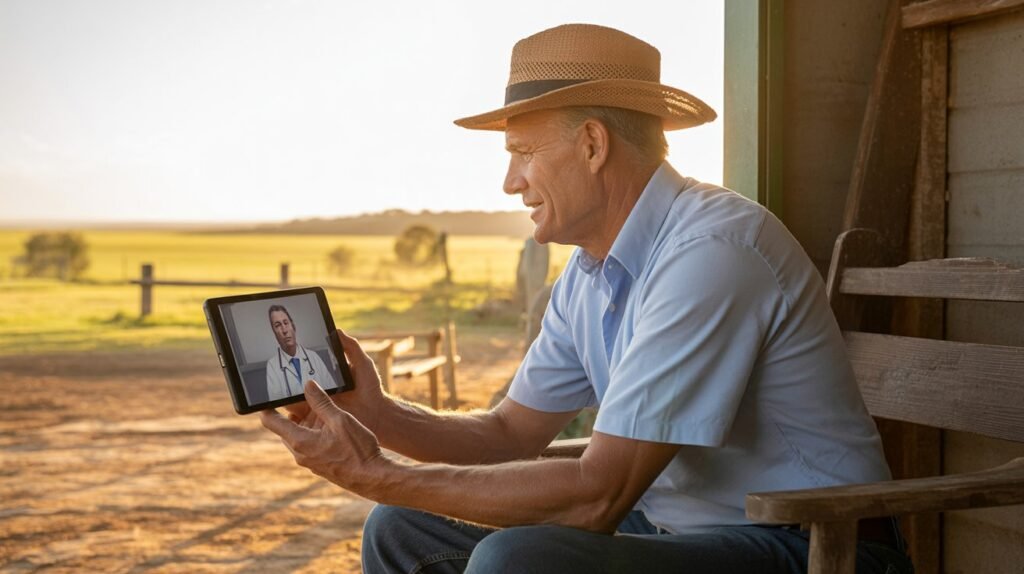Australia’s a big place. Too big, sometimes. If you live in Melbourne or Sydney, a GP might be a five-minute drive away. But swap that for outback Queensland, or a tiny farming town in WA, and suddenly it’s not so simple. A quick check-up can mean hours of driving, lost wages, fuel costs, and stress. Which is why the humble Telehealth Appointment is quietly rewriting the script for healthcare in rural Australia.
The Distance Problem
We talk about “the tyranny of distance” in this country for a reason. Health services aren’t evenly spread, and small communities often go without. Some towns don’t even have a permanent doctor. Residents rely on locums who fly in and out, sometimes only once a month. Imagine having a sick child and being told to wait three weeks for the next clinic day. Or driving five hours for a fifteen-minute consult. That’s the reality for many.
This is where a Telehealth Appointment makes the impossible, well, possible. With a smartphone and internet connection, suddenly the barrier of distance starts to shrink.
The Unexpected Benefits
At first, people saw telehealth as a “pandemic stopgap”—a way to keep the system running while clinics were closed. But something interesting happened. Patients realised it wasn’t just about avoiding a virus. It was easier. More flexible. Less exhausting.
Take a farmer who can’t leave their property during lambing season. Or an elderly woman who depends on her daughter for transport but doesn’t want to “bother her” for a routine prescription renewal. A Telehealth Appointment turns those impossible tasks into quick, manageable ones. And no, it doesn’t replace emergency care. But for day-to-day medicine? It’s a game-changer.
Building Trust in a Screen
Of course, there’s hesitation. Some people worry about “talking to a screen” instead of a person in the room. Fair. Healthcare has always been built on relationships, and moving that online feels a bit cold at first. But many rural Australians are finding that trust builds surprisingly quickly.
A Telehealth Appointment still means speaking to a qualified GP or specialist. Still confidential. Still professional. The only difference? You’re in your kitchen instead of their office. Over time, patients realise the core doesn’t change—the care, the advice, the reassurance—it’s all still there.
Bridging the Specialist Gap
Here’s another quiet win. In the bush, getting access to specialists is tough. Cardiology, dermatology, psychiatry—you name it, the waitlists are long, and the travel even longer. Telehealth opens a new door.
Instead of driving eight hours to Brisbane for a skin check, patients can have a Telehealth Appointment with a dermatologist who reviews images remotely. Mental health services, too, have seen a huge leap. Rural Australians, who often struggled to access psychologists, can now book regular telehealth sessions without uprooting their lives.
The Technology Hurdle
Now, let’s be real. Telehealth isn’t a magic bullet. Rural internet is patchy, unreliable, sometimes non-existent. A Telehealth Appointment only works if the connection does. Dropouts, frozen screens, audio glitches—they’re frustrating.
But here’s the thing: even with imperfect infrastructure, people still prefer it to the alternative. And with investment into better regional internet, this barrier is slowly lowering. It’s not perfect yet. But it’s improving.
Cost and Accessibility
Another common question: does it cost more? The answer is no—at least, not necessarily. Many GPs bulk-bill for telehealth. Medicare rebates apply, just like an in-person consult. For patients who once spent $100 on fuel just to get to town, a Telehealth Appointment can mean significant savings.
There’s also a hidden benefit: fewer missed appointments. When you don’t have to plan an entire day around seeing the doctor, you’re more likely to follow through. That consistency leads to better long-term health outcomes.
A Cultural Shift
It’s not just about logistics, though. There’s a cultural shift happening. For years, rural Australians have lived with a certain resignation—healthcare will always be harder out here. A Telehealth Appointment chips away at that mindset. It says: you don’t have to accept second-best because of your postcode.
It also eases some of the mental load. Parents don’t feel guilty about keeping a child home from school to make the trip. Elderly patients don’t feel like a burden for asking family members to drive them. Small changes, big impact.
What It Doesn’t Replace
Important to say: telehealth isn’t a fix-all. There are times you must see someone in person. Physical exams, blood tests, imaging, emergencies—those still need hands-on care. A Telehealth Appointment can’t stitch a wound or listen to your lungs directly. But it can screen, advise, prescribe, and refer. Which, for many rural Australians, is enough to keep them healthier for longer.
Looking Ahead
The question now isn’t whether telehealth will last. It’s how far it’ll go. As technology improves, and more GPs integrate telehealth into their practices, we’ll see it become the norm for everyday care. For rural areas, that’s huge. A Telehealth Appointment could be the first step in levelling the healthcare playing field across Australia.
It won’t solve everything. But it’s already solved enough.
Final Thought
Healthcare shouldn’t be a postcode lottery. Yet for years, that’s how it felt in rural Australia. Distance made it harder. Resources were thin. People went without. Telehealth is changing that. One Telehealth Appointment from DocMate at a time, the gap is closing.
And maybe, just maybe, the future of rural healthcare looks a little less daunting than it used to.
Want more to read? Visit dDooks.


